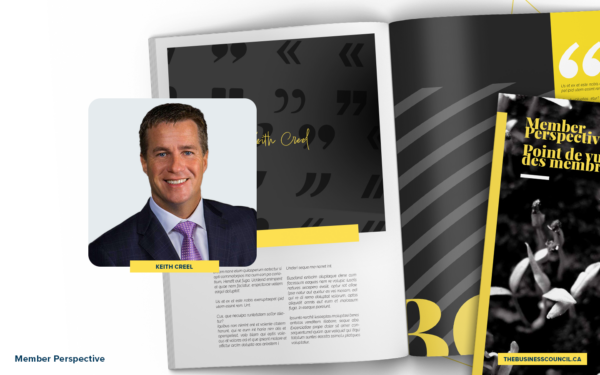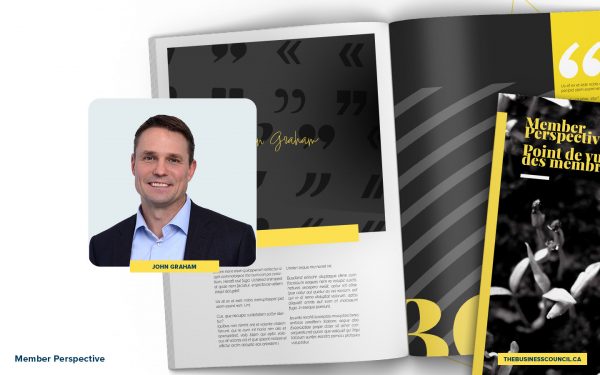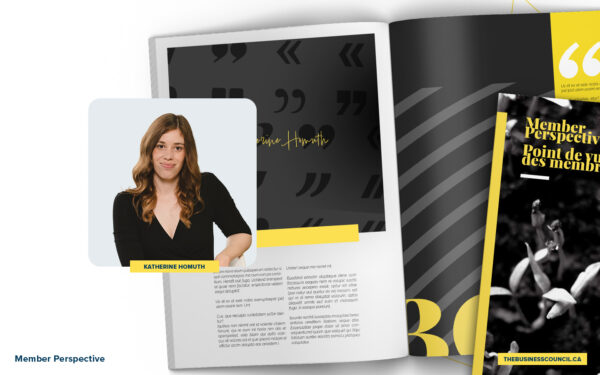Tough times don’t last but tough teams do
In light of the COVID-19 emergency, we’ve temporarily suspended our regularly scheduled series of conversations with Canadian CEOs. But we’re not going away. Instead, we’re going to pivot to the health emergency itself. We’re going to explore the impact on companies and workers across the country. And we’re going to find out how business leaders are responding to crisis.
Linda Hasenfratz, President & CEO of Linamar shares her company’s fast-paced ventilator production initiative, how they’re keeping workers safe, and what we might learn from how other countries have responded to the COVID-19 crisis.
Latest Podcasts
Transcript
Goldy Hyder:
Welcome to a special edition of Speaking of Business. I’m Goldy Hyder, of the Business Council of Canada. It goes without saying, it’s a really challenging time for people across the country. That’s why we’ve put our regular podcast on hold, to focus on how business leaders across Canada are being affected by the COVID crisis, and how it is they’re responding.
Goldy Hyder:
One of the most pressing concerns in dealing with this virus is ensuring that hospitals and frontline workers have the equipment they need to treat a large number of patients, and many Canadian businesses are stepping up to help. One of them is Linamar, a Guelph-based global manufacturer of auto parts and industrial machinery. Linda Hasenfratz is Linamar’s CEO, and she joins me this morning.
Goldy Hyder:
Welcome, Linda.
Linda Hasenfratz:
Thanks, Goldy.
Goldy Hyder:
Now, usually you’re busy manufacturing products for the transportation and industrial sectors, a world leader in that. But, how is it now that you’ve had to retool, to help produce ventilators? And, how challenging is it to turn something as big an operation as Linamar around, to be able to meet that demand?
Linda Hasenfratz:
I mean, obviously given the current situation, we wanted to try and help out, as much as we could. It’s interesting, because my eldest daughter actually was living in the UK, up until about three weeks ago. As a result, had a frontline seat to what was happening a little bit earlier than North America, and came to home to us with a real message of urgency around what was happening, and what was likely to happen here.
Linda Hasenfratz:
One of the things she brought up to me was ventilators, that were obviously becoming a big issue in Europe and saying, “Hey, you guys should look into that at Linamar.” As a result, before, really, a lot of people were talking about what was going on in terms of shortages on ventilators, we were already on the job, so thanks to Katie for that.
Linda Hasenfratz:
We started doing some research. We were working with a partner that we are already doing a little bit of work in the medical device space, Synaptive. Synaptive helped us to identify different ventilator designs, different companies that were working here in Canada and elsewhere, in order to try to narrow down which one made the most sense. That took a bit of time, and in conjunction, by this time, with our governments, narrowed down to a couple of manufacturers right here in Canada that we thought it made sense to just try and get tooled up a higher level, given they already had approved units out there and being sold in the market. That would really help us to speed time to market.
Linda Hasenfratz:
Linamar is actually a company that is incredibly good at crisis management, and helping customers out when they have a crisis. In fact one of our customers calls us the 911 of the automotive industry, because they know that if they have a problem, they can call us, and we will mobilize extremely quickly, gather the team. We have the technical strength, the financial strength, and the team, and the responsive attitude, to be able to move really quickly, and get what’s needed done. It’s exactly that attitude that we’ve brought to this ventilator project.
Goldy Hyder:
That’s cool, the 911 analogy because, of course, that implies speed. So, the question really is, how quickly do you think you can get these products out the door now? Because this is a big change.
Linda Hasenfratz:
It’s obviously a different product, but certainly there’s similarities in manufacturing. We manufacture highly precise products, with very tight tolerance ranges in terms of the precision within which those products are made. We assemble them utilizing a variety of components that we’re buying in, some that we’re making. The basic concept of doing that with a ventilator is actually not dissimilar, so we can use a lot of the same sort of systems and process that we have for launching a new job.
Linda Hasenfratz:
There are, of course, machine components within these systems, as well so it’s not entirely new to us. Of course, it’s a different product, we need to get to know it, we need to understand the requirements, and work closely with our customers on these products. But, the concept of high precision manufacturing assembly is, of course, something that we’re very much used to so we can pivot into a different product without it being a massive learning curve. I think, again, that’s something that Linamar is quite good at.
Linda Hasenfratz:
On top of that, we also utilize a philosophy in using flexible, programmable equipment for our lines. Now, we do that not because we thought in advance we might have to switch to make ventilators, but we do it to better be able to match line capacity to customer demand, and then re-utilize equipment into new programs. So, just by retooling you can take a flexible piece of equipment and put it on a different job. So, that’s something that is core philosophy of Linamar, operationally, of how we work, and that flexibility has helped us not just within our auto side, but also now to pivot into a different type of product.
Goldy Hyder:
That’s interesting. Now, I know that in every company, certainly the number one focus is on the safety of your workers under the best of times, that’s always a paramount consideration. But now, in these unprecedented times, how are you adjusting, and ensuring the safety of your workers, so that they feel comfortable coming to work, and doing the ventilator work, and other work that you continue to do?
Linda Hasenfratz:
Yeah absolutely, that’s a great question. You’re absolutely right, the health and safety of our people is absolutely top of mind.
Linda Hasenfratz:
Right from the start, for any employees that are still coming to work, we have established safe working protocols. Clearly, keeping a distance from each other, ensuring that we’ve ramped up hygiene and cleaning, so that surfaces are being cleaned on a much more regular basis, obviously providing PPE equipment for our people to keep them safe. In fact, that whole area is one that we are doing a lot of research in, and looking to continue to develop, and make even more robust by looking at what other countries around the world have done. China’s a great example, they’ve been through this, they’re a month and a half ahead of us in terms of dealing with this pandemic. They have already started safe relaunch procedures, so we can learn from them.
Linda Hasenfratz:
Frankly, I think it’s something that we all need to be very focused on, because although many jurisdictions are locked down, shut down, and people not going to work, that can’t last forever. I mean, it can’t last forever because economically, it’s disastrous of course. But, we do need to figure out how to get back to work safely, so to me, we need to really balance the length and severity of the lockdown, to really make sure we’ve flattened the curve of the infection, so that our healthcare organizations can manage it. Obviously, the more severe the shutdown is, the shorter it can be, and China’s a great example of that. But, we can’t be on lockdown with people not working for months.
Linda Hasenfratz:
So we need to start thinking a little bit about okay, how much longer are we going to be down, in order to flatten that curve, which is critical? And then, how are we going to work when we come back out? Because obviously, when we come back out, the virus will not be eradicated so we need to figure out how to safely work with the virus around us. Where people feel safe coming to work, and are safe coming to work. Maybe safer coming to work than not coming to work, that should really be our goal.
Linda Hasenfratz:
So, we’ve been adding protocol to that system, adding ideas to it in terms of screening and testing, potentially, employees before they enter the building. And containment strategies, so we know where they are at all times. They’re going to preassigned areas for break time, or for lunch time, and we know exactly who’s around them. So, in the event that somebody did contract the virus, that we know exactly where they’ve been, who they’ve been exposed to, and we can really try to contain the situation, and make sure that the potentially affected people are informed, and dealing with that situation.
Goldy Hyder:
Certainly no surprise. As I said, the paramount issue of safety of workers is a consistent theme, even during the good times. Good to know that you’re on top of it all, I’m sure that is allowing for the output that you’re hoping for in some of the ventilator programs and other things you’re doing.
Goldy Hyder:
Speaking of other things, it’s not just ventilators that Linamar’s announced that it’s working on, there’s some local initiatives and stuff. Do you want to just tell us what else you’re doing during this pandemic?
Linda Hasenfratz:
Yeah, absolutely. We, like so many companies out there, are trying to do whatever we can to help our local communities. We’re working with local hospitals in our different communities around the world, to donate any personal protective equipment that we had on hand. We’re also using our global supply chain to source additional PPE for our frontline healthcare workers in our local communities. In some areas of the world, we have transportation divisions, they are working with local food banks, to make sure the food is getting delivered to those food banks, and also helping to make sure that vulnerable people, that are in isolation, are getting food, and getting healthy food delivered to them.
Linda Hasenfratz:
Lots of different ways that companies can help, and we’re certainly trying to do everything that we can.
Goldy Hyder:
Well, thank you for doing that, and for your leadership.
Goldy Hyder:
Now, Linamar of course is a very global company. So, you’ve got plants in Canada, the United States, Europe, and China as well. I’m wondering if you can just share with the listeners what differences are you seeing in how this pandemic is playing out in different parts of the world? The story you just said about Katie is revealing, in the sense that other countries that came out the of gate first in terms of the virus, you can see where it’s going, you can see what to do about it. What lessons have you been able to learn and apply, given your global exposure, and you saw this in other parts of the world?
Linda Hasenfratz:
Just starting out from a broad perspective as opposed to a company perspective I think, as I mentioned a moment ago, we saw how China dealt with the situation. A very severe tight, tight lockdown for two weeks, a little bit longer in some of the areas that were more central, like Wuhan. But, a tight, tight lockdown, and then coming back out of it.
Linda Hasenfratz:
Right now, our plants in China, 95% of our employees are back to work. Our customers are not at full production yet, but they’re in the process of ramping back up, and should be back up to full production levels within the next, let’s say, six to eight weeks. So, we’re in recovery mode in China, and as I said, we can learn from some of the safe working protocols that have been put in place there, what we can do here.
Linda Hasenfratz:
Pivot now to Europe, or North America, where we’re seeing shutdowns and lockdowns, but they’re nothing close to the severity and the tightness of the lockdown that went on in China. As a result, we’re seeing the lockdowns happening for longer periods of time, because they’re not being as effective at flattening off that curve. So, as a result, they have to be in place a little bit longer. I think that’s a big lesson.
Linda Hasenfratz:
I also think if we look around the world at what countries have been really successful at managing the situation, I think clearly testing, widespread testing, has been a very important element in trying to manage the situation. Look at Korea, look at Germany, I feel like they’ve done a great job of widespread testing, which is helping to identify people without symptoms that do have the virus. If we know they’re positive, we can self-isolate them, and then they’re not infecting others. I think that we need to learn from that, and try and incorporate more in the way of testing.
Linda Hasenfratz:
From a company perspective, maybe that even means doing some testing, or some kind of monitoring, of our employees when we do come back to work. When we, again, coming back to that recovery mode, and creating a safe work environment, maybe that needs to be a piece of it. I think that’s something that we should be thinking about, and considering.
Goldy Hyder:
Yeah, well said. Now, on a personal level, I just thought I’d ask, how is this impacting you? You’re a relatively newly appointed Chancellor at Western. I know you’ve got, what, three of your four kids are there? You’ve got graduations coming up. Has this hit home, that it’s not going to be a normal summer?
Linda Hasenfratz:
Oh well, absolutely. It’s been very tough for the universities, the schools. I think that they’ve managed it extremely well, moving quickly to remote learning. I’ve got a front row seat to that with, as you say, three of my kids are Western students, and they’re here at home, but working very hard because they’re in classes, they’re trying to do exams, they’re trying to do assignments. We’ve all got our little corner of the house, where we are tucked away, and working away. That seems to be really working.
Linda Hasenfratz:
I think it’s very tough on the students, particularly the graduating students. My second eldest daughter, Emily, is graduating this year, and it’s tough because all those graduation, end of university experiences, and trips, and all the things that the students like to do at graduation are all on hold. I think that’s very tough, emotionally, when I talk to other young people as well.
Linda Hasenfratz:
Not to mention, for all the rest of us, trying to figure out how to work remotely, and stay connected, and it’s tough. I think people are struggling with those emotions, and trying to figure out how to work in a different way, in a very different environment. Certainly, we’re all in uncharted territory here, and we’re all learning a lot.
Goldy Hyder:
You know Linda, I know you pretty well now, and I know you to be two things that I think we need most right now, and I want to wrap on that note, which is both resilient and optimistic. Tell us how you feel this is going to unfold, and what good is going to come from this?
Linda Hasenfratz:
Yes. Well, of course it’s hard for most people to feel that way in the situation, because it just seems so difficult. But, I really do think that we need to focus out beyond the next four to six weeks, which of course are going to be very tough, I hear, in North America, and know that we’re going to get to the other side of it. I think that we’re doing the right things, we’re making sure frontline healthcare workers have the equipment that they need, that people have enough money flowing to them, even if they are on layoff, to avoid an enormous economic shutdown.
Linda Hasenfratz:
We are locked down as best we can, to try to contain the virus, and we are going to get through this. That’s something that we talk to our team at Linamar a lot about, that tough times don’t last, but tough teams do, and we’re one tough team. I think that it’s really important to have those positive messages.
Linda Hasenfratz:
Just circling right back to where we started the conversation, I think that the ventilator project and some of the community work that we’re doing have been incredible morale boosters for our people.
Goldy Hyder:
Yeah, I’m sure.
Linda Hasenfratz:
In a time when things are tough. We’ve got something positive to focus on and do, and that makes everybody feel really good. You’ve got to focus on those positives, and keep morale strong, and know that we’re going to get through this. There’s going to be something on the other side, we’re going to learn from it, we’re going to be stronger from it. We just need to focus on, I think, a bit of a shift from, over the next four to six weeks, from fear to hope.
Goldy Hyder:
What a great place to end. Tough team with a tough leader. Thank you for doing this, Linda.
Linda Hasenfratz:
Thanks, Goldy. It’s my pleasure.
Goldy Hyder:
You’ve been listening to my conversation with Linda Hasenfratz, the CEO of Linamar.
Goldy Hyder:
We’ve heard a wide range of voices and perspectives in this special podcast series, and I encourage you to listen to more of our conversations at SpeakingOfBiz.ca, that’s Biz with a Z, or wherever you get your podcasts.
Goldy Hyder:
Until next time, I’m Goldy Hyder, thanks for joining us.









